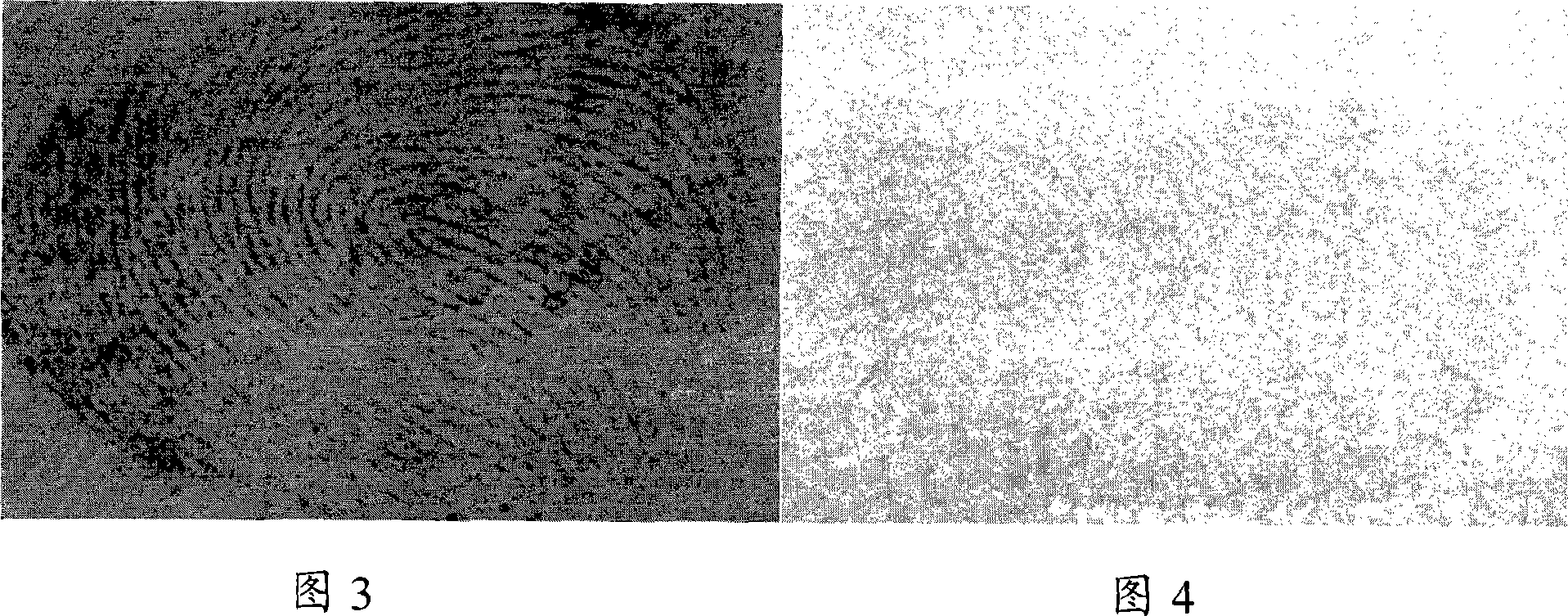Method for strengthening latent fingerprint observation on non-permeating object by adopting gold nano-material
A gold nanometer, non-permeable technology, which is applied in the analysis of materials, material analysis by optical means, and analysis by making materials undergo chemical reactions, etc., can solve the problems of inability to show old fingerprints and low sensitivity, and achieve low cost and environmental protection. friendly effect
- Summary
- Abstract
- Description
- Claims
- Application Information
AI Technical Summary
Problems solved by technology
Method used
Image
Examples
Embodiment 1
[0013] Preparation of gold nano solution: 50ml of HAuCl with a concentration of 0.1mmol / L 4 Solution, heating and stirring to boiling, then adding 30ml concentration is the mixed solution of the sodium citrate of 1.33mmol / L and the tannic acid of 0.0025mmol / L, continues to boil for 15 minutes, is cooled to room temperature. Add 25ul Tween 20 to the above solution, stir well, and adjust the pH to 2.4 with citric acid solution. Immerse the glass to be tested in the gold nano solution for 5 minutes, take it out and rinse it with distilled water to remove the unadsorbed gold nanoparticles.
[0014] Fingerprint development: prepare 50 ml of citric acid-sodium citrate buffer solution with pH=3.8. Take 75mg of silver acetate and dissolve 210mg of hydroquinone in the buffer solution. Put the object glass to be displayed into the above solution and soak for 10 minutes. Take it out, rinse it with distilled water to remove excess silver salt, soak it in the fixer solution for 4min, ta...
Embodiment 2
[0016] Preparation of gold nano solution: 50ml of HAuCl with a concentration of 0.14mmol / L 4 Solution, heated to boiling, add 30ml concentration and be the mixed solution of the sodium citrate of 3.5mmol / L and the tannic acid of 0.0019mmol / L after stirring, continue to boil for 10 minutes, be cooled to room temperature. Add 30ul Tween 20 to the above solution, stir well, and then adjust the pH to 2.5 with citric acid solution. Immerse the aluminum foil to be tested in the gold nano solution for 13 minutes, take it out and rinse it with distilled water to remove the unadsorbed gold nanoparticles.
[0017] Fingerprint development: prepare 50 ml of citric acid-sodium citrate buffer solution with pH=3.6. Get 75mg of silver acetate, 250mg of hydroquinone dissolved in 50ml of citric acid buffer solution. Put the tinfoil of the object to be revealed into the mixture and soak for 15 minutes. Take it out, rinse it with distilled water to remove excess silver salt, soak it in the fix...
Embodiment 3
[0019] Preparation of gold nano solution: 50ml of HAuCl with a concentration of 0.6mmol / L 4 Heat the solution to boiling, add 30ml of a mixed solution of sodium citrate with a concentration of 10.0mmol / L and 0.0012mmol / L tannic acid, stir, continue to boil for 13min, stop heating and cool to room temperature. 25ul Tween 40 was added to the above solution, and after stirring for 18min, the pH was adjusted to 2.6 with citric acid solution. Immerse the plastic to be tested in the gold nano solution for 60 minutes, take it out and rinse it with distilled water to remove the unadsorbed gold nanoparticles.
[0020] Fingerprint development: prepare 50 ml of citric acid-sodium citrate buffer solution with pH=3.8. Take 80mg of silver acetate and 220mg of hydroquinone dissolved in the buffer solution, then mix the two solutions. Put the object plastic to be displayed into the mixture and soak for 15 minutes. Take it out, rinse it with distilled water to remove excess silver salt, soa...
PUM
 Login to View More
Login to View More Abstract
Description
Claims
Application Information
 Login to View More
Login to View More - R&D
- Intellectual Property
- Life Sciences
- Materials
- Tech Scout
- Unparalleled Data Quality
- Higher Quality Content
- 60% Fewer Hallucinations
Browse by: Latest US Patents, China's latest patents, Technical Efficacy Thesaurus, Application Domain, Technology Topic, Popular Technical Reports.
© 2025 PatSnap. All rights reserved.Legal|Privacy policy|Modern Slavery Act Transparency Statement|Sitemap|About US| Contact US: help@patsnap.com


